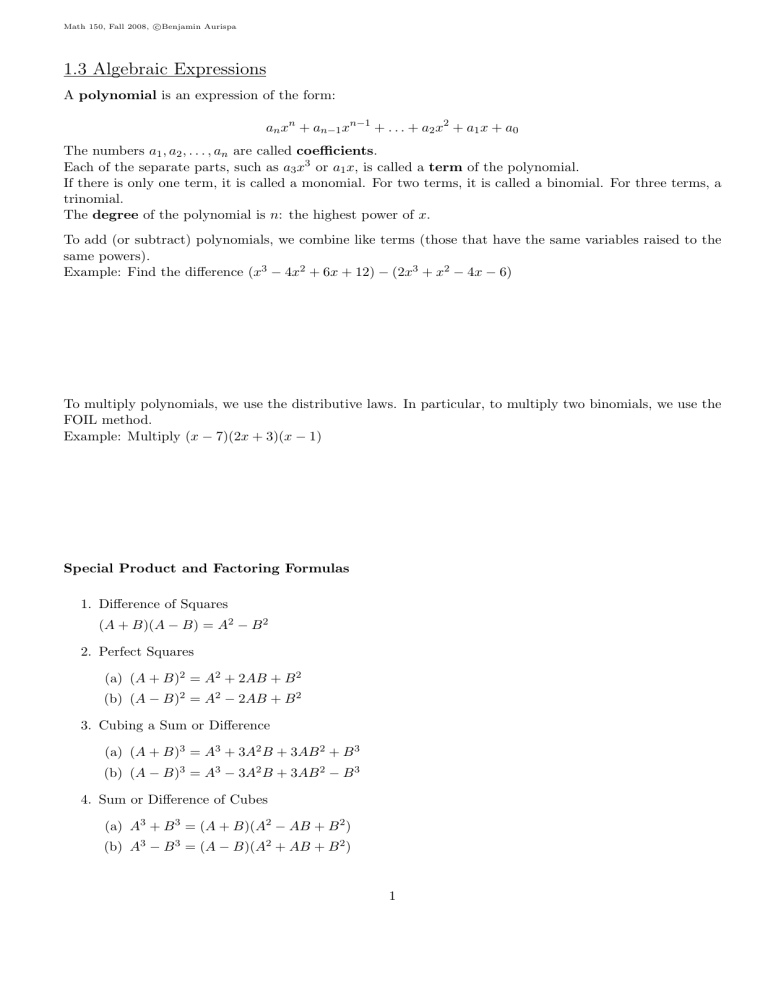Document 10504113

Math 150, Fall 2008, c Benjamin Aurispa
1.3 Algebraic Expressions
A polynomial is an expression of the form: a n x n
+ a n − 1 x n − 1
+ . . .
+ a
2 x
2
+ a
1 x + a
0
The numbers a
1
, a
2
, . . . , a n are called coefficients .
Each of the separate parts, such as a
3 x
3 or a
1 x , is called a term of the polynomial.
If there is only one term, it is called a monomial. For two terms, it is called a binomial. For three terms, a trinomial.
The degree of the polynomial is n : the highest power of x .
To add (or subtract) polynomials, we combine like terms (those that have the same variables raised to the same powers).
Example: Find the difference ( x
3 − 4 x
2
+ 6 x + 12) − (2 x
3
+ x
2 − 4 x − 6)
To multiply polynomials, we use the distributive laws. In particular, to multiply two binomials, we use the
FOIL method.
Example: Multiply ( x − 7)(2 x + 3)( x − 1)
Special Product and Factoring Formulas
1. Difference of Squares
( A + B )( A − B ) = A
2 − B
2
2. Perfect Squares
(a) ( A + B )
2
= A
2
+ 2 AB + B
2
(b) ( A − B )
2
= A
2 − 2 AB + B
2
3. Cubing a Sum or Difference
(a) ( A + B )
3
= A
3
+ 3 A
2
B + 3 AB
2
+ B
3
(b) ( A − B )
3
= A
3 − 3 A
2
B + 3 AB
2 − B
3
4. Sum or Difference of Cubes
(a) A
3
+ B
3
= ( A + B )( A
2 − AB + B
2
)
(b) A
3 − B
3
= ( A − B )( A
2
+ AB + B
2
)
1
Math 150, Fall 2008, c Benjamin Aurispa
Examples : Expand the following.
• (2
√ x + 3)(2
√ x − 3)
• ( x
3 − 4)
2
• ( x
2 − 2)
3
Factoring Steps
1. Factor out all common factors.
2. See if you can use a special factoring formula.
3. See if you can factor by grouping.
4. Use trial and error.
Examples : Factor the following.
• 8 x
2 − 24 x + 18
• 36 x
2 − 25
• x
3 − 27
2
Math 150, Fall 2008, c Benjamin Aurispa
• 2 x
2
+ 11 x − 21
• x
3
+ 3 x
2 − x − 3
• ( a
2
+ 2 a )
2 − 2( a
2
+ 2 a ) − 3
To factor expressions with rational exponents, first factor out, if possible, the smallest power of x .
• Factor x
− 3 / 2
+ 2 x
− 1 / 2
+ x
1 / 2
Its easy to check if you factored correctly. Just multiply back out to double check.
3
Math 150, Fall 2008, c Benjamin Aurispa
1.4 Rational Expressions
A rational expression is a fractional expression where both the numerator and denominator are polynomials.
The domain of any algebraic expression is the set of values that the variable can be.
So far, we have two things to look for to determine the domain:
• The denominator can’t be zero. If a value of x makes the denominator zero, we must exclude it from the domain.
• For even powered roots (square roots, fourth roots, etc), whatever is under the radical must be ≥ 0.
Examples : Find the domains of the following rational expressions.
1.
x
2 x − 3
2.
x 2
√ x
− 9
3.
x
2
√
+ 3 x x + 3
Working with rational expressions is just like working with fractions.
To multiply rational expressions, factor the numerator and denominator, multiply, and then simplify by cancelling common factors in the numerator and denominator.
To divide rational expressions, multiply by the reciprocal.
To add or subtract rational expressions, you MUST have a COMMON DENOMINATOR (just like with fractions).
Examples
• x
2 − 1 x 2 − 7 x + 12
· x
2 − x − 6 x + 1
4
Math 150, Fall 2008, c Benjamin Aurispa
•
4 y
2 − 9
2 y 2 + 9 y − 18
2 y
2
+ y − 3
÷ y 2 + 5 y − 6
• x x 2 + x − 2
2
− x 2 − 5 x + 4
Compound fractions are fractional expressions where the numerator and/or denominator are themselves fractional expressions.
Examples:
• x y x x + y
+ y x
•
3(1 + x ) 1 / 3 − x (1 + x )
− 2 / 3
(1 + x ) 2 / 3
5
Math 150, Fall 2008, c Benjamin Aurispa
Rationalizing the Denominator or Numerator
As before, rationalizing means to get rid of any radicals. We do this by multiplying by the conjugate . The
For example, the conjugate of A + B
√
C is A − B
√
C . What’s the point? When you multiply these two expressions together you get an expression that has NO radicals: ( A + B C )( A − B C ) = A 2 − B 2 C
Examples
• What are the conjugates of:
2 − 3 7
√ x − 3 − 9
√ x +
√ y
• Rationalize the denominator of
4 − x
√ x
.
• Rationalize the numerator of
√
3 + x + 2
.
3
1.5 Equations
Linear equations can always be written in the form ax + b = 0.
To solve linear equations, use basic algebra, but remember what you do to one side, you MUST do to the other side.
Example: Solve the following linear equation for the variable x .
ax + b
= 2 cx + d
6
Math 150, Fall 2008, c Benjamin Aurispa
Quadratic equations can be written in the form ax
2
+ bx + c = 0 with a = 0.
To solve a quadratic equation by factoring, we use the Zero-Product Property , which tells us that if
AB = 0, then A = 0 or B = 0. Note: This does NOT work if the right hand side is not 0. So, if AB = 2, it does NOT mean that A = 2 or B = 2.
Example: Solve this equation by factoring: 2 x
2 − x = 3
To solve quadratics that are written as perfect squares, just take square roots of both sides.
Example: Solve ( x − 5)
2
= 17
If an equation does not easily factor, we can use the method of completing the square . The idea is to get the equation in the form of the example above, where the equation has a perfect square in it.
To make x
2
+ bx a perfect square, add ( b
2
)
2
.
Example: Solve this equation by completing the square: 3 x
2 − 6 x − 1 = 0
What happens if a quadratic is not factorable or you can’t remember how to factor it? Use THE QUADRATIC
FORMULA. It ALWAYS works.
The roots (or solutions) of the quadratic equation ax
2
+ bx + c = 0 where a = 0, are: x =
− b ±
√ b 2 − 4 ac
2 a
Example: Solve the equation 3 x
2 − 6 x − 1 = 0 by using the Quadratic Formula.
7
Math 150, Fall 2008, c Benjamin Aurispa
The discriminant of a quadratic equation is D = b
2 − 4 ac . It is the part of the quadratic formula that is underneath the square root. The discriminant tells us how many real solutions the equation has. There are
3 cases.
1.
D > 0
2.
D = 0
3.
D < 0
Example: How many real solutions does 4 x
2 − 5 x + 2 = 0 have?
An object thrown up at an initial speed of v
0 ft/s will reach a height of h feet after t seconds based on the formula h = − 16 t
2
+ v
0 t
Suppose I throw a ball up with a speed of 48 ft/s.
a) When will the ball fall back down to me?
b) When will it reach a height of 32 ft.?
c) Will it reach a height of 64 ft.?
8
Math 150, Fall 2008, c Benjamin Aurispa
Other types of equations
• Equations with Fractionial Expressions. Multiply both sides by the LCD and then solve.
x + 5 x − 2
=
5 x + 2
+
28 x 2 − 4
However, we must then check for extraneous solutions , which are potential solutions that do not actually satisfy the original equation. Whenever we multiply an equation by something with the variable, or whenever we square both sides of an equation, we must check for extraneous solutions. In general, it is a good idea to check your answers.
• Equations with Radicals: Isolate the square root on one side of the equation and then square both sides. Remember to check for extraneous solutions.
√
5 − x + 1 = x − 2
9
Math 150, Fall 2008, c Benjamin Aurispa
• Equations of Quadratic Type: The idea is to get the equation in the form of a quadratic, which we know how to solve. After solving, again check for extraneous solutions.
x
4 − 5 x
2
+ 4 = 0 x
4 / 3 − 5 x
2 / 3
+ 6 = 0
• Absolute Value Equations: Isolate the absolute value and separate into cases.
| 4 x + 7 | = 2
10






